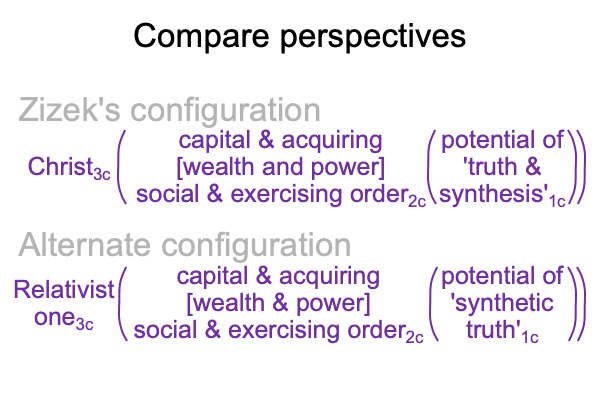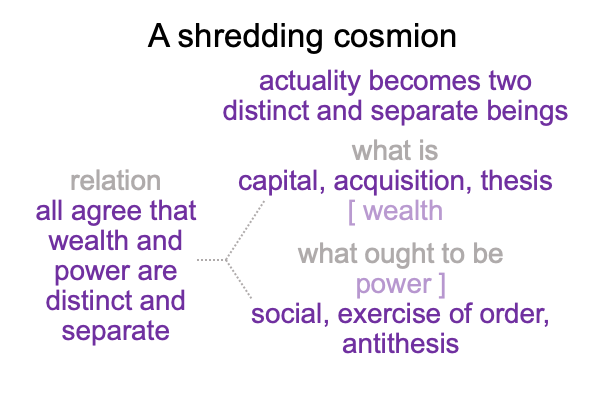0278 Once again, the title of chapter five concerns the status of something not human, not divine and not natural.
Yes, that must be artificial intelligence (AI).
0279 If I posed to AI the following two nested forms, and asked, “Please choose the more rational of the two, which would the AI daemon select?”

0280 Is the answer obvious?
The AI program will select the one that I want it to choose, since its desire is for my engagement. Then, AI will give a rationalization.
0281 But, the question remains. Which is more rational?
Does “rational” imply “sensible”? Does “sensible” imply “existence”?
Has the question become, “Which does not exist?”
The apparently material actualities2c appear identical. They are also ontological. The apparently immaterial normal contexts3c and potentials1c are not the same. They are also transcendentals.
0282 Can transcendentals alter, even destroy then reconstruct, ontologies?
Why does Zizek start a chapter that seems to be about AI with “the cosmion” as a case of pagan Christianity. Cosmion-oriented Christianity is not really pagan, but alien, from a Western point of view.
Zizek suggests that the Russian Orthodox tradition poses the superior nested form, because it does not rip the actuality2c apart, then reconstitute it as a monster. The northern European Enlightenment tradition poses the inferior nested form and yields a monster that threatens all civilizations four centuries later.
0283 This is an extraordinary claim, and Zizek does not develop the argument in the same way as this examiner.
Say what?
I have completely independent way to make Zizek’s case.
What follows parallels points 0050 to 0076 in Looking at Hugh Ross’s Book (2023) “Rescuing Inerrancy”, appearing in Razie Mah’s blog for the month of July, 2025. Then, what follows lifts off in a trajectory of its own.
0284 Peirce’s category of secondness consists of two contiguous real elements. For Aristotle’s hylomorphe, these real elements are matter and form. The contiguity is placed in brackets for good notation. I select the the term, “substance” to label the [contiguity]. Aristotle’s hylomorphe is matter [substance] form.
The Russian Orthodox tradition remains true to Aristotle. The terms of “matter” and “form” do not label things themselves. They label real elements of a holistic thing. The distinction is subtle, yet crucial. If matter and form are regarded as distinct and separate things, then the distinction and separation become actual and the things… er… the matter and the form become normal contexts and potentials. Matter and form no longer belong to the category of secondness.
This is precisely what the western Enlightenment does to the hylomorphe of a perspective level actuality, but not to Aristotle’s hylomorphe.
Well, maybe the Enlightenment does the same to Aristotle’s hylomorphe, but that is another story.
0285 Here is the dyad for a thing and a cosmion2c, as a perspective level actuality.

0286 Modern English language is tricky.
Yes, I can say that [substance] is the contiguity between matter and form. Then, as soon as I start talking about substance, [it] becomes like… a thing itself… when it is really a contiguity between two real elements that constitute a thing of event.
I don’t know how Russian is different from English. But, my examination of Zizek’s digression indicates that somehow… the Russian Orthodox way of talking may not reify “substance” in the same way that English tends to.
0287 Now, all the languages entangled with the so-called “Western Enlightenment” have similar issues. At first, [substance] is not a thing, it is a contiguity between two real elements. Yet, as soon as one utters the spoken word, “substance”, an implication is ready-at-hand in the Western mind. A spoken word images and indicates an actual referent.
However, can anyone picture or point to the actual referent of the term, “substance”?
0288 Look at the way the word is used in the English lexicon. Who knows what to picture or point to?
0289 If someone says to me, “I stepped on a substance on the way to work.”, then I think, “I hope you wiped it off your shoes before coming into the building. Who knows what you stepped in.”
The event, walking [substance on] shoe, or walking [step on substance now on] shoe, is an encounter2, an actuality2. In order to be understood, one must ascertain its normal context3 and potential1.
But, wait a moment. Haven’t I already reified (converted a contiguity into a thing) the term, “substance”. Oh, come to think of it, someone has already reified the term for me.
0290 Apply that word usage to [the contiguity] between the thesis that will constellate into “capitalism” and the anti-thesis that will constellate into “socialism”, portrayed above.
Here is a picture.

The indivisible substance, [wealth and power], reifies into a declaration that we all agree that wealth and power are distinct and separate.
Yeah, one indivisible substance turns into two independent things. The actuality2c is no longer a single thing, it is two things.
0291 A judgment ensues, because the declaration brings what is (of capital & acquisition) and what ought to be (of social & exercise of order) into relation.
Say what?
Wealth associates to what is, one of the three elements of judgment. “Wealth” goes with capital, acquisition and thesis.
Power associates to what ought to be, one of the three elements of judgment. “Power” goes with social, exercise of order and antithesis.
The remaining element of judgment, relation, characterizes an agreement, reifying and separating wealth and power.
